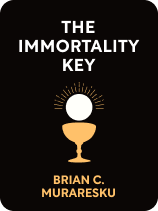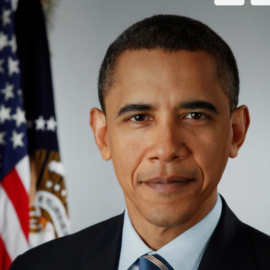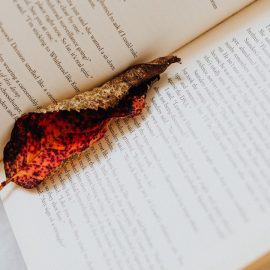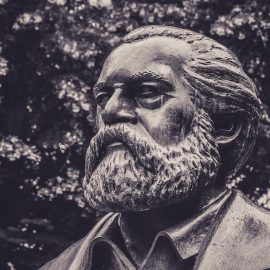

This article is an excerpt from the Shortform book guide to "The Immortality Key" by Brian C. Muraresku. Shortform has the world's best summaries and analyses of books you should be reading.
Like this article? Sign up for a free trial here.
What is Brian Muraresku’s book The Immortality Key about? What is the key message to take away from the book?
The Immortality Key, published in 2020, is Brian Muraresku’s deep dive into the origins of Christianity and its overlap with pre-existing pagan religious customs. Muraresku argues that Christianity began as a female-led mystical cult that used psychedelics to induce transcendental states to connect with the divine.
Below is a brief overview of The Immortality Key: The Secret History of the Religion with No Name by Brian Muraresku.
The Immortality Key: The Secret History of the Religion with No Name
Muraresku is a scholar of ancient languages and law, holding degrees from Brown and Georgetown Universities. He has spent a decade in search of evidence to support what he calls the “pagan continuity hypothesis with a psychedelic twist.” The pagan continuity hypothesis theorizes that when Christianity arrived in Greece around AD 49, it didn’t suddenly replace the existing religion. Rather, Christian beliefs were gradually incorporated into the pagan customs that already existed there. In this way, the two traditions coexisted in a syncretic form for some time before Christianity became a religion that was considered entirely distinct from its pagan predecessors. And even then, many of those pagan customs, such as wine-based rituals, have remained a part of Christianity to the present day.
The “psychedelic twist” Muraresku adds in this book is his hypothesis that the pagan traditions existing in the Greco-Roman world at the time of the emergence of Christianity (and long before it) involved rituals using psychedelic brews, and that those were the origins of what would become the Christian Eucharist.
In his book The Immortality Key, Muraresku delves into questions about what psychedelics have to offer humanity. He considers how crucially important these mystical rituals were to the ancient Greeks and asks how we might glean some wisdom from these traditions to reconsider the place of psychedelics in our lives in the modern world.
Proving Muraresku’s theory involves two major claims that we’ll explore in this guide:
- Christian beliefs were incorporated gradually into the ancient Greco-Roman world by blending them with existing polytheistic pagan traditions.
- Those pagan traditions included the ritual use of psychedelic brews, which formed the basis for the Christian Eucharist.
(Shortform note: The Eucharist is a central ritual practice in Christianity, focused on the commemoration of the crucifixion and resurrection of Christ. The word “eucharist” in Greek means “thanksgiving,” so the emphasis is placed on giving thanks for the sacrifice Christians believe Jesus made for humanity. The ritual involves consuming small portions of bread and wine, which are believed to be the body and blood of Christ. This ritual originates from a Biblical scripture in which Jesus instructs his followers to “do this in remembrance of me” as he’s preparing for his imminent death.)
First, we’ll establish the context by discussing what kinds of religious beliefs and customs existed in the Greco-Roman world when Christianity arrived on the scene. Then, we’ll look at some features of early Christianity that may have appealed to Greek polytheistic pagans and examine how those traditions became intertwined. This will support the pagan continuity hypothesis.
Next, we’ll turn to the psychedelic element and look at the evidence supporting the claim that ancient people were using psychedelics in their religious practice. Finally, we’ll discuss how these mystical psychedelic rituals were eliminated from Christian practice and replaced with a placebo. Throughout the guide, we’ll define terms and concepts related to the relevant religious and ritual practices, compare Muraresku’s work with related research, and explore connections to psychedelic experiences in different times and places.
Pre-Christian Greek Religion
Muraresku says we can’t possibly understand the origins of Christianity without understanding the religions that already existed in that region at the time it emerged, so this is where we’ll begin. He centers his pre-Christianity investigation on ancient Greece, for two overlapping reasons:
1) The Greco-Roman world is where Christianity became a major religious and political entity.
2) Ancient Greece is credited as being the cultural foundation of Western civilization. So, if Muraresku’s theory is correct, that would mean pagan psychedelic rituals contributed not just to Christianity, but to the development of Western culture as we know it today.
At the time of the birth of Christianity, the Greeks practiced a polytheistic religion, with mythology including 12 major gods and goddesses, and many other minor ones. This religion included a rich mystical tradition. This means that practitioners sought to attain a profound spiritual connection with the supernatural. The real religious experience, Muraresku says, was happening in ritual ceremonies, as a direct individual connection to the divine and mystical.
Here is a basic timeline of the important historical events relevant to this investigation, all of which we’ll discuss in more detail throughout the guide:
- Circa 1500 BC: Eleusinian Mysteries are established in Eleusis, Greece.
- Circa 1300 BC: Earliest written record of Dionysus worship occurs in Mycenae, Greece.
- 405 BC: The Bacchae (an ancient Greek tragedy about Dionysus) is written.
- 146 BC: Greece becomes part of the Roman Empire.
- AD 1: Christ is born in Palestine.
- AD 49-58: The apostle Paul brings Christianity to Greece, writing the first books of the Bible.
- AD 120-150: The Gnostic Gospels are written by followers of Christ.
- AD 392: Roman emperor Theodosius outlaws the Mysteries and other pagan practices, establishing Christianity as the official religion of the Roman Empire.
This timeline shows that there are around 300 years in which both the pagan traditions and Christianity were being practiced in Greece. In the following sections, we’ll describe some of the major features of the ancient Greek mystical tradition, beginning with the most sacred one, the Eleusinian Mysteries.
The Eleusinian Mysteries
Muraresku’s investigation of the pagan continuity hypothesis begins with the Eleusinian Mysteries, a secret cult practice that existed for almost 2,000 continuous years. The Eleusinian Mysteries were the heart of the religious tradition in Greece, he explains, as well as in Greek settlements in Italy and Spain, when Christianity arrived in the region in the first century AD.
Muraresku argues that the Mysteries are a crucial link between polytheistic pagan traditions and Christianity, and he says that the mystical experience happening here was likely facilitated by psychoactive substances.
The Eleusinian Mysteries involved secret rituals celebrated annually around the Fall equinox (harvest time) from about 1500 BC until AD 392, when the Mysteries were outlawed by the strictly Christian emperor Theodosius. So, the Mysteries continued to be practiced for around 300 years after the arrival of Christianity.
Despite the enormous timespan and the profound importance of the Mysteries, there is no detailed written description of exactly what happened during these rituals. The reason? Participants were forbidden to reveal the secret, on punishment of death. This is why the tradition was called the “Mysteries.” There are, however, some vague accounts of participants’ experiences in the initiatory rituals.
Some of the facts Muraresku gives us about the Eleusinian Mysteries from archaeological and written sources are as follows:
- The rituals were devoted to Demeter and Persephone: In mythology, Persephone spends half of the year in the underworld and half above ground with her mother Demeter. So, she undergoes a continuous cycle of death and rebirth, which causes the seasons. The rituals, then, are a means for humans to communicate with Persephone, so she can reveal the secrets of death and rebirth to them. (Shortform note: Some people actually believe that the central myth of Christianity—God, the Father, sent his son, Jesus, to Earth to die and be resurrected—is essentially a “masculinized” version of the Greek story of Demeter and Persephone.)
- There was a divine feminine element to the Mysteries: In the earlier days of the Eleusinian Mysteries, Muraresku tells us that only women could be initiated. Later, men would be allowed, but women remained in charge of determining who was worthy of initiation. We’ll discuss the importance of this divine feminine element in the next section. (Shortform note: As noted above, religious studies scholar Mara Lynn Keller agrees that women were central and sacred to the Mysteries and were the leaders of the rituals, but she argues that the Mysteries were always open to anyone who undertook the serious half-year preparation required for initiation.)
- The rituals centered around a sacred drink: Muraresku points out that written sources indicate that a drink called kykeon was central to the rituals, as a sacrament prepared by honored priestesses. He says kukeon is known to be barley-based, so it’s assumed to be beer. Muraresku believes it was not regular beer, but beer containing psychoactive compounds. Later in the guide, we’ll discuss his evidence to support this. (Shortform note: Also spelled kykeon, this beverage is described in Homer’s Iliad as containing water, barley, herbs, and goat cheese, and in The Odyssey, the sorceress Circe uses it to make a magic potion that turns men into pigs.)
- Participants were transformed by the experience: In the vague written accounts of participants’ experience in the Mysteries, Muraresku says there is a common theme of radical transformation. He says there are descriptions that recount the feeling that the participant was transformed into a god/goddess themselves and understood that they were immortal. This experience is referred to as “apotheosis” or deification—meaning “one who becomes a god,” and this concept has been used in the Christian church in reference to the Eucharist and consuming the flesh and blood of Christ. Muraresku believes this indicates a connection between the Mysteries, the psychedelic experience, and the Eucharist.
(Shortform note: One of the more common experiences reported in recent research by people who have had psychedelic experiences is that of a perceived encounter with “God” or an “ultimate reality.” A Johns Hopkins study reported that more than two-thirds of self-identified atheists shed that identification after a psychedelic experience. Another study concluded that “psilocybin can occasion complete mystical experiences in the majority of people studied,” with mystical experience defined as “a sense of unity, or the experience of becoming one with all that exists.”)
The Divine Feminine Divergence
Muraresku emphasizes throughout the book that a crucially important element of the Eleusinian Mysteries, and of the ancient Greek religion in general, was the divine feminine element. The Greek pantheon included both male and female deities, and the Temple of Demeter being home to one of the most sacred traditions shows us how highly revered the goddesses were.
Also, Muraresku says, sources indicate that women had always been the brewers of the sacred beverage of the Mysteries, and the leaders of the ceremonies. Art and literature from this general time period, in this region of the world, frequently depict women at the center and as leaders of religious rituals and ceremonies. This is important, he says, because it shows how the pagan and Christian religious traditions diverged over time—in particular how the exclusion of women from religious leadership was one of the major turning points that solidified Christianity as a very different tradition from pre-Christian paganism, and in fact from the earliest form of Christianity.
Proto-Christianity and the Pagan Continuity Hypothesis
Now that we understand the religious setting in Greece at the time, we can examine how Christianity rooted itself into Greek culture, gradually intertwined with the existing religious customs, and ultimately spread throughout the Romanized world.
It’s believed that Christianity arrived in Greece in AD 49 with Saint Paul, one of the apostles of Jesus. However, Christianity didn’t become the official religion of the Greco-Roman world until AD 392. Until this time, the polytheistic pagan and Christian traditions existed simultaneously throughout the region. So, these three centuries are the key time period for understanding the continuity between the existing pagan traditions and Christianity. Muraresku refers to the Christian practices during this time period as “proto-Christianity.”
(Shortform note: Muraresku’s pagan continuity hypothesis itself isn’t as controversial as his claims about psychedelic use. The continuity between pagan traditions and early Christianity has been supported by evidence from all around the area of the world that was dominated by the Roman Empire. Scholars have noted many instances of Christian elements being combined with pre-Christian pagan elements. These include local gods and goddesses being turned into Catholic saints (for example the Celtic goddess Brigid becoming the Catholic Saint Brigid), and Christian holidays, such as Christmas and Easter incorporating pre-Christian pagan symbolism.)
Christianity was not forced on the Greeks, so Muraresku points out that they had to have adopted it willingly. He asks, how would people with such rich, long-standing, entrenched beliefs and practices come to accept an entirely new religion? And he argues that they wouldn’t—unless the new religion was familiar enough to fit into what they already believed and practiced.
In this section, we’ll discuss the characteristics, beliefs, and practices of proto-Christianity that were likely to have appealed to a polytheistic pagan community with a rich mystical tradition.
(Shortform note: In addition to Muraresku’s explanation that the new religion contained familiar elements that would have appealed to the Greeks, historians also believe Christianity took hold in part because it attributed divine power to rulers. Early Christian emperors like Constantine claimed to be emissaries of God, and they attributed their battle victories and the empire’s expansion to the power of God.)
The Gnostic Gospels
Muraresku explains that direct experience of God has always been the goal of mystical traditions, but this kind of experience was eventually suppressed by the Christian “establishment.” He says an important source for understanding proto-Christianity, and its overlap with Greek paganism, are the Gnostic Gospels. These are a collection of books purportedly written by followers of Jesus, likely between AD 120 and 150. Although the writers themselves professed to be devotees of Jesus and claimed to be revealing truths from him, leaders of the early Christian church omitted these books from the Biblical canon, and they were lost to history until they were unearthed in Egypt in 1945.
Muraresku says the Gnostic Gospels were originally part of the Christian scriptures but were later eliminated because they encouraged experiencing direct union with God. He explains that the more orthodox leaders of the Church wanted the priests to be the only arbiters of God because people who have their own direct experience of God are harder to convert and control. So they ultimately sought to keep the populace from these mystical experiences.
Muraresku believes these gospels provide a window into the beliefs and traditions that defined proto-Christianity, and that they explain why it would have appealed to the ancient Greeks—because, he says, Christianity in its original form was itself a mystical tradition.
Jesus as Dionysus
So, Muraresku establishes that the form of Christianity that arrived in Greece in AD 49 was likely characterized by mysticism, making the philosophy and practices understandable to the existing population. But why would people who already have a pantheon of gods and goddesses have any interest in a new god or prophet? Muraresku says this new prophet would have to be relatable and recognizable, and he argues that this was the case because Jesus was essentially another form of Dionysus, the god of ecstasy who was worshiped in the Eleusinian rituals.
The two had several similarities that would have made Jesus a recognizable (and acceptable) figure to the Greeks, including:
Immaculate conception:
- Dionysis is the son of the god Zeus and a young human woman named Semele, who is described as a “maiden” or “virgin.” He’s conceived when Zeus visits Semele in the form of an eagle and is described in the mythology as the only begotten son of God. His birthday is celebrated around the Winter solstice.
- Jesus is the son of God and a young virgin woman, Mary. He’s conceived when God visits Mary in the form of a dove. He’s described in the Gospel of John as the only begotten son of God. He’s said to have been born around the Winter solstice.
Turning water into wine:
- Turning water into wine was Dionysus’s specialty. Dionysus was associated with a miracle that occurred every year on January 5 when a spring in the temple would start flowing with wine, called “God’s Gift Day.”
- The Gospel of John tells the story of Jesus performing the miracle of turning water into wine at a wedding feast. The wedding is said to have occurred on January 6, which Christians now celebrate as “Epiphany.”
Blood as wine offers immortality:
- The Bacchae (the story of Dionysus, written by Euripedes in 405 BC) refers to wine as the “blood of Dionysus” and says drinking it will lead to immortality.
- The Gospel of John describes bread and wine as the “true food and true drink, [Jesus’] flesh and blood, that promises eternal life.” John’s words are the identical Greek words used in The Bacchae in reference to Dionysus.
Visual similarities:
- Both Dionysus and Jesus are depicted with long flowing hair and associated with a purple cloak and a crown of thorns. The crown of thorns was the signature way of identifying Dionysus and his disciples and is a symbol associated with the crucifixion of Christ.
Muraresku argues that these similarities can hardly be coincidental. He says people of this time and place would not have accepted a god without wine, so these descriptions of Jesus, most obviously in the Gospel of John, written between AD 90-100, would have been a perfect way to get Greeks to relate Jesus with Dionysus.
Refrigeriums: Depictions of the Divine Feminine and the Eucharist
Another overlap between Greco-Roman pagan customs and Christianity, which may be the most obvious link to the Eucharist, is the ancient Roman custom called the refrigerium. This was a funerary feast common in the pre-Christian Roman world that served the function of honoring and communicating with the dead. Two central features of the refrigeriums were wine and women. Wine was said to enable contact between the living and the dead, and sacred priestesses prepared and dispensed it.
Muraresku says any new religion introduced to the Greeks (in this case, Christianity) would have to include a divine feminine element in order for the Greeks to adopt it. So, he argues that divine femininity was another essential feature of proto-Christianity. In the refrigeriums, we see the combination of sacred wine and sacred femininity, coming together in a mystical ritual that continued for hundreds of years after the introduction of Christianity to the Greeks and Romans.
There are hundreds of miles of catacombs underneath Rome, and artwork still remains on the walls and ceilings. Scholars debate whether some of the art depicts pagan refrigerium rituals or Christian Eucharist rituals because it contains elements of both. Muraresku describes scenes of female-led, or possibly entirely female, rituals centered around wine, bread, and fish. Believed to be from the third century AD, he argues that these artworks are likely depictions of that time period when the pagan and Christian rituals were inseparable.
Another area of the catacombs has art dated to the late third or early fourth century that clearly depicts women officiating ceremonies. These scenes include the words “love” and “peace,” as well as the phrases “mix it up for me!” and “hand over the calda.” Calda, Muraresku explains, literally translates to warm (or hot) stuff, but scholars say it refers to a drink that was a mixture of wine, hot water, and herbal intoxicants, commonly drunk in the winter. He says these scenes show women presiding over groups of men, indicating that women were in charge of the ceremonies and also of “mixing” and dispensing the wine.
(Shortform note: In this video, art historians discuss a Roman artwork from around AD 400. This was after Christianity was officially adopted and pagan customs were outlawed, but the artwork has the distinctive pagan features that Muraresku discusses—a woman who appears to be a priestess making some sort of offering at an altar. The scholars also point out that an oak tree and some ivy in the art are symbolic of the gods Jupiter and Bacchus.)
Based on what he learned from the Roman catacomb art and the related scholarship, Muraresku argues that these refrigeriums were the origin of the Eucharist. He argues that these were rituals for remembering the dead, which evolved into rituals for remembering the death and resurrection of Christ. And the wine, he says, was what enabled the living and the dead to be in contact.
The Psychedelic Element
Now that the pagan continuity hypothesis is defended, the next task is to show that the pagan and proto-Christian ritual sacraments were, in fact, psychedelic brews.
Again, how did Christianity take hold in a world with such a rich mystical tradition? In addition to having beliefs and iconography that paralleled that of the existing traditions, Muraresku believes the practices also had to have been similar enough to be meaningful for people to adopt. Proto-Christianity, therefore, incorporated mysticism, through the use of a magical wine that promises redemption and immortality. In this section, we’ll look at the written and archaeological evidence Muraresku presents for the existence of psychoactive beer and wine in the ancient Greco-Roman world.
Psychoactive Beer
Muraresku first attempts to find evidence that the kukeon used in the Eleusinian Mysteries was in fact a psychedelic beer. We’ll look at the evidence he presents, from both the historical written record and the physical archaeological remains of sites from the region, in the early days of Christianity.
Written and Historical Evidence
Muraresku begins by discussing a written record that says kukeon was barley-based, as well as images of barley carved on the temple, to show that kukeon was a type of beer. But he says it’s also known that beer of that time was not like the beer we drink today. He believes kukeon was likely ergotized beer.
Ergot is a fungus that infests barley. Even today, brewers have to be careful about removing it from the grain. In high amounts it can be lethal, but in lower amounts it acts as a hallucinogen.
It’s likely that most early beer had some ergot in it, Muraresku explains, because it would have been difficult to create the sterile conditions necessary to remove all of it. So, he says early people in various parts of the world were probably drinking (at least mildly) hallucinogenic beer. Those at Eleusis, he argues, may have been brewing it that way purposefully, knowing the right techniques and dosages, in a “controlled contamination” process. For physical evidence of this, Muraresku turns to new advances in archaeological methods.
Archaeochemistry and Archaeobotany
Recent scientific advancements in archaeology make it possible to test for traces of chemical and botanical compounds on ancient vessels. Unfortunately, Muraresku learned that all the vessels excavated at Eleusis had been cleaned before this method became available, so none can be tested. He also discovered that there are numerous uncleaned vessels from sites in the region that are owned and stored at the Vatican—as of yet, they haven’t allowed them to be tested. So, his archeological investigation had to turn to other sites where Greek settlements had formed abroad. Here he finds the evidence he’s looking for.
A Greek settlement on the eastern coast of Spain, settled around 450 BC, was found to have a similar ritual space to the one in Eleusis. Since it also had depictions of Demeter and Persephone, archaeologists believe it could have been a version of the Mysteries taken abroad. At this site, traces of ergotized beer were identified in a small chalice and on the teeth in a human male jawbone, indicating that it was being consumed. Also, he says, the shape, style, and small size of the chalice indicate that it was a ritual vessel, and whatever was drunk from it was likely very potent.
So, this and several other sites in Spain found evidence of psychedelic brews contemporaneous with the time of Eleusis. According to Muraresku, this evidence suggests that the kukeon of the Eleusian mysteries could have been psychedelic.
Psychoactive Wine
Wine was clearly a component of Dionysian rituals for millennia, and copious ancient art and written sources depict ritual consumption of wine, so it’s established that people were drinking wine ceremonially in Greece at the time of early Christianity. Once Dionysus was incorporated into the Mysteries, Muraresku believes the wine that would have replaced the kukeon also would have been prepared with specific herbs to make it psychedelic.
Like beer, wine in ancient times was different from the wine we know today. It was lower in alcohol content, and yet there are many accounts suggesting it was far more potent, so scholars conclude it must have contained other substances.
The most compelling written evidence Muraresku presents here is a Greek encyclopedia of herbal medicine called De Materia Medica from AD 40-90. This document describes 56 different detailed recipes for wines spiked with botanical ingredients, including those with psychoactive properties. The author describes one mixture, wine mixed with black nightshade, as “producing not unpleasant visions.” This is solid evidence that the Greeks during the time of proto-Christianity were mixing potent psychoactive herbs into their wine.
(Shortform note: Much of the inspiration for Muraresku’s research comes from the work of scholar Carl A.P. Ruck. In his article entitled Entheogens in Ancient Times: Wine and the Rituals of Dionysus, Ruck discusses how early wine fermentation necessitated the addition of botanical ingredients to give it potency. He says the fermentation process without modern methods, combined with the custom of diluting the wine with water, only yielded a beverage with about 1% alcohol content, and yet there are descriptions reporting severe intoxication after only a couple of glasses of such wine. This means, Ruck concludes, they were clearly mixing other potent ingredients into their wine.)
Archaeological Evidence
In terms of the archaeological evidence, Muraresku points first to depictions in ancient art that show priestesses or goddesses mixing mushrooms and other unidentified herbs into wine.
But the most exciting evidence suggesting the presence of psychedelics comes from Pompeii, Italy. Although the city was destroyed by a volcano in AD 79, the volcanic ash preserved everything exactly as it was at the moment the volcano hit—including hard evidence of many herbal preparations mixed with wine.
Muraresku explains that just outside the main gates of the city is a site called “Villa of the Mysteries,” a 40,000 square-foot ritual compound that contains clear evidence that Greco-Roman Dionysian mysteries were being practiced there. In walking distance from this ritual site is a farm that contained many large vessels for storing liquid, indicating that what was being stored in them was being prepared in mass quantities to supply people.
Testing revealed the vessels contained wine mixed with a number of botanical ingredients. Traces identified include opium, cannabis, henbane, and black nightshade—all mind-altering substances. Muraresku believes this provides the strongest evidence that people were using psychedelic beverages as part of their rituals in the proto-Christian era.
Elimination of Mystical Traditions
By the fourth century, religious traditions had become deeply fractured. On the one hand, there were the Gnostic proto-Christians, who were practicing the mystical traditions aligned with the pagan practices; and on the other, there were a growing number of powerful leaders who aimed to establish Christianity as an ecclesiastical tradition. This means the elite, particularly in Rome, wanted to establish a hierarchical church, within which only the leaders had access to power and divinity—this would become Orthodox Christianity. Muraresku says establishing such a tradition meant the elimination of two things sacred to the mystical tradition: women and drugs.
Exclusion of Women
One way to ensure the Mysteries couldn’t survive, Muraresku says, was to exclude women from the priesthood or official church leadership. The Mysteries relied on women to prepare the sacrament—it was a knowledge that was considered their domain. So, removing women from leadership positions was crucial for eliminating all traces of pagan customs.
(Shortform note: In 2021 Pope Francis changed some policies to allow women some expanded roles in the church, such as giving readings and assisting priests with Mass. However he, and the Catholic Church as a whole, remain staunch on their policy that women cannot be ordained into the priesthood.)
But, he asks, what happened to the sacramental wine traditions? Where did the knowledge go? And he argues that this issue is at the basis of the long era of witch hunts throughout Europe.
Muraresku says the persecution of women by the church, especially of those with healing and plant knowledge, continued for centuries, and ultimately resurfaced later in the witch trials. He says over time the church systematically exterminated the knowledge of the preparations, not just individuals.
In reference to a document in which the Catholic Church called witches “the most dangerous of all enemies to the human race and the Christian Church,” Muraresku asks how could women cooking up “potions” in their homes be that dangerous to such a massively powerful organization? And he argues that it’s because those potions made people realize they could directly commune with the divine and that would make the church obsolete if people had access to that experience. A record from AD 1320 specifically orders Inquisitors to target those who “abuse the sacrament of the eucharist….by using them or things like them in their sorcery.” Muraresku believes this to be evidence of a longstanding attempt by the Christian church to eradicate the mystical element of the earlier rituals, by suppressing and eliminating women and their knowledge of drugs.
(Shortform note: Historians estimate that around 40,000 people, most of them women, were executed for witchcraft in Europe during the Middle Ages. Some believe these campaigns were largely about a competition for followers between the Protestant and Catholic churches. Once the majority of the population was convinced that witchcraft was a source of evil in the world, the two branches of Christianity set out to compete for who could execute the most witches and prove themselves to be the more efficient church.)
Stigmatizing of Drugs
Muraresku says that mysticism was bad for the social order because it allowed everyone the sacred experience, and emphasized women’s important role in spiritual leadership. This undermined the authority of the Church as well as the patriarchal order. The major problem the powerful elites wanted to eliminate, he says, was that people who “tasted the forbidden fruit” would not submit to orthodox teachings. So, the Orthodox branch of the church persecuted the Gnostics, and the prevailing power structure (backed by the emperor) eventually allowed them to dominate. By the fourth century AD, the Gnostic mysteries had been all but eradicated. At this point, Muraresku believes the original (psychedelic) sacrament was replaced by a placebo, which became the Eucharist as we know it today.
Muraresku also points out that this “anti-drug” campaign has continued throughout the history of the Christian church, not only in the persecution of women but in the colonization of indigenous peoples, as well as being observable in the attitudes of Christianity today toward drugs.
He presents some examples of this to show that the Christian church has an explicit agenda to eradicate mysticism, specifically because it makes people impossible to convert and control. Two key examples of this include:
1) The Aztecs and ololiuhqui: According to Muraresku’s research, ololiuhqui was the most commonly used entheogen (medicinal hallucinogen) by the Aztecs. In a 1629 letter, a Spanish missionary said the Aztecs consult it for gaining knowledge “beyond human understanding.” The priests seized the ololiuhqui and kept people from accessing it, even razing the fields where it was being grown.
2) Native Americans and peyote: Peyote, a psychedelic cactus, has long been used as an entheogen by some Native American tribes. Muraresku tells us that in 1890 the US launched a concerted effort to eliminate it, saying it was “interfering with the work of the missionaries” on the reservations.
These examples are meant to show that the opposition by the Christian church to mysticism, and specifically to mystical experience through psychedelics, is not simply a matter of preference or prejudice. According to Muraresku’s argument, it’s a 2,000-year deliberate effort to restrict the population’s access to a transcendental awareness that might liberate them from the need for scriptural dogma.
Immortality and the Psychedelic Experience
In addition to the above evidence, Muraresku looks at the way people describe their ritual experiences in ancient sources, and he compares them to modern-day experiments with psychedelics. There’s an undeniable similarity.
The Ancient Ritual Experience
In descriptions of the Eleusinian Mysteries, it’s said that the ancient secret was that one must die before dying. According to Muraresku’s research, the most common description by initiates is that they underwent a transformative experience involving a metaphorical death and rebirth and were given a sense of their own immortality.
In AD 364, the Christian emperor Valentinian attempted to shut down the Mysteries, but after substantial pushback, he eventually relented because the pagan high priest, Praetextatus, told him that outlawing the mysteries “would make the life of the Greeks unlivable” and implied that the future of all humanity would suffer if these rites were lost. There was a belief that these rituals held the whole human race together. Likewise, Muraresku tells us, an inscription on St. Paul’s Monastery (10th-11th century) in Attica, Greece says “if you die before you die, you won’t die when you die.” And in Greek, the Catholic Eucharist is sometimes called the pharmakon athanasius, meaning the “drug of immortality.”
The theme of death, rebirth, and immortality resurface often in descriptions of psychedelic experiences, from cultures around the world, throughout history. In looking at such cross-cultural descriptions, Muraresku says that we can find evidence in many places and times of rituals that involve ingesting a sacred beverage for the purpose of a mystical or transcendental experience.
Additionally, ancient Greek sources refer to wine as a “drug against grief” and a “treatment for misery,” and Muraresku’s investigation into modern-day psychiatric research shows that psychedelics are proving to be an effective treatment for mental health conditions such as PTSD and depression.
The Modern Psychedelic Experience
For comparison to the experiences described by ancient people, we can look at some of the research in psychedelics today. In a 2022 study, the Johns Hopkins Center for Psychedelic and Consciousness Research reported that 75% of respondents rate a single psychedelic session as one of the top five—or the single most—meaningful experiences of their life. One of the most common experiences people report after having a psychedelic session is ego death: a sense of oneness with everything. They also often report feeling a union with the divine, and a sense that they’re transformed in some meaningful way.
Muraresku points out that these reactions are reminiscent of the “apotheosis” belief underlying the Eucharist. He points to a 2016 study of cancer patients who underwent a psilocybin treatment session, in which 87% of participants reported increased life satisfaction and well-being that lasted for months. One of those participants was a woman whose diagnosis had sent her into an existential crisis. Although she had identified as an atheist, she said during her session she had experienced the feeling of “being bathed in God’s love.”
Researchers on the psychedelic frontier, such as those at Johns Hopkins, believe these treatments have great potential for easing end-of-life suffering, fear of death, and healing psychological trauma. And Muraresku believes we could be on the verge of rediscovering the secrets the ancient Greeks believed made life worth living.

———End of Preview———
Like what you just read? Read the rest of the world's best book summary and analysis of Brian C. Muraresku's "The Immortality Key" at Shortform.
Here's what you'll find in our full The Immortality Key summary:
- The secret that kept ancient Greeks and early Christians from fearing death
- The origins of Christianity and its overlap with pre-existing pagan customs
- The real reason why women can't be priests







Darya, this is an extremely well written, easy to read and helpful summary of this seminal book The Immortality Key by Brian Muraresku.
I badly wanted to read this book but I didn’t have much time so I resorted to your summary which provided me with all its important ideas, reasoning and results. Thank you!